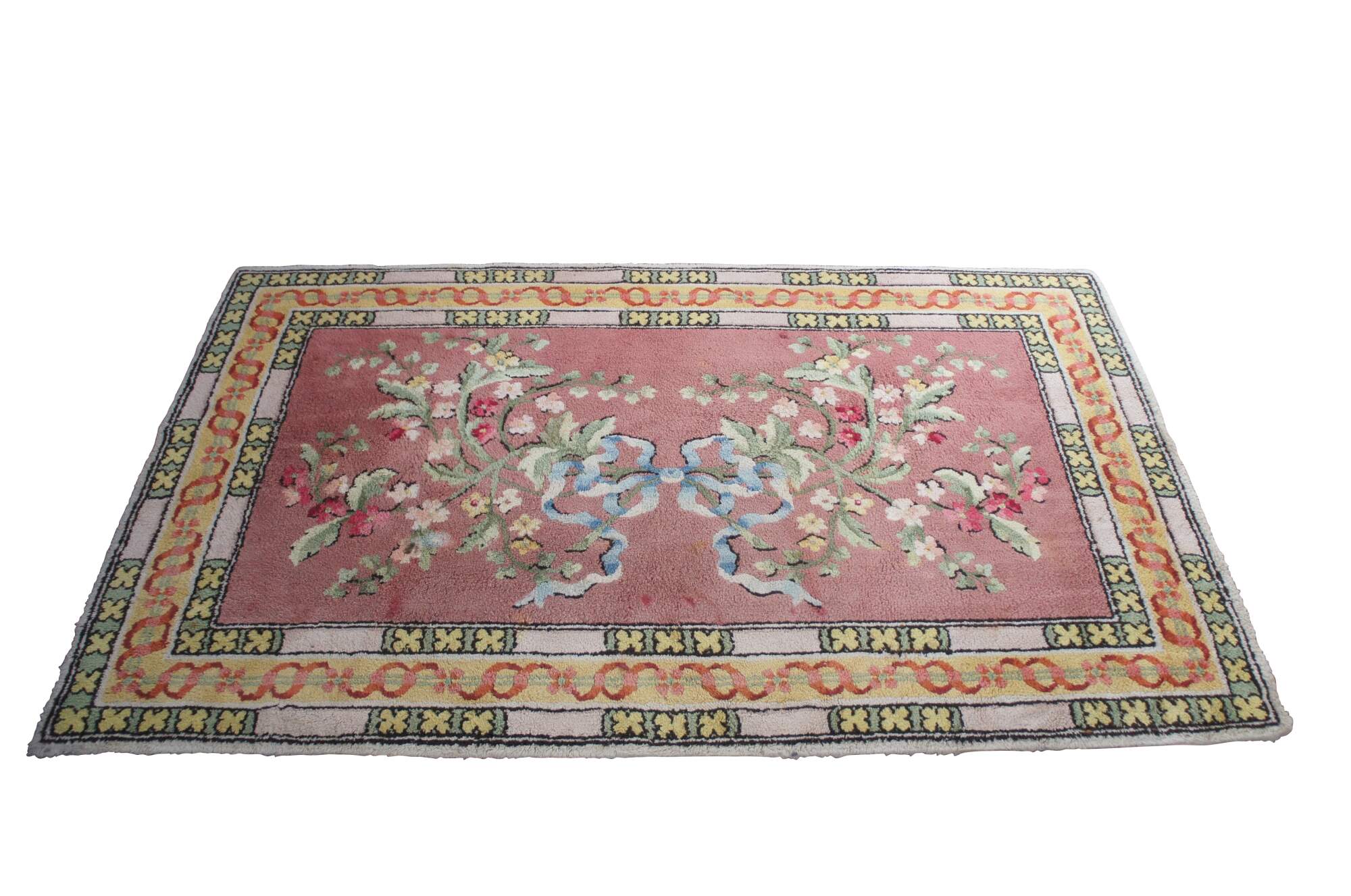
Shipping:
Free Shipping Included
Delivery:
Estimated 2-15 Business Days
Payments:
Credit Card, Check, Cash, PayPal, Apple Pay, Venmo
Returns:
30 Days 100% Money Back Guarantee, Buyer Pays Return Shipping
Description
Vintage pure virgin wool rug featuring a pink field with blue Neoclassical ribbon medallion surrounded by flowers. Made in Madrid Spain for J Frederick Gagel. Pinks, reds, blues, greens, yellow, beige / cream.
The Royal Tapestry Factory of Santa Bárbara is one of the royal factories for the manufacture of luxury objects created by the mercantilist policy of the Spanish Enlightenment . It was founded in 1720 by Philip V , in imitation of the French royal workshops that followed the Colbertist model , after the interruption of the import of Flemish tapestries after the Peace of Utrecht , which provided the pieces for the royal quarters. Since 1889 it has been located in the Pacífico neighborhood of Madrid, in a building built between 1889 and 1891. It currently maintains the activity for which it was created. 1
History
The Quail Hunt is one of the cartoons that Goya gave to the Royal Factory in 1775, the year in which he arrived to supply models that were later converted into tapestries.
In the beginning it was directed by Jacobo Vandergoten and his family, from Antwerp , and they occupied a property on the outskirts of Madrid, next to the Puerta de Santa Bárbara , from which the Royal Factory takes its name. Low heddle looms were installed that were made from models made by court painters. Flemish models from the school of David Teniers III and Philips Wouwerman were followed in these first years . In 1734, his son James Vandergoten "the Younger" inaugurated another factory that worked on the more modern "high heddle".
However, its true importance begins in 1746 during the reign of Ferdinand VI , with the unification of the two manufactures and the decisive royal patronage. The styles of the cartoons were renewed, now looking to Italian painters such as Jacopo Amiconi , Corrado Giaquinto or French, among whom Louis-Michel van Loo and Michel-Ange Houasse stand out , with the collaboration of Andrés de la Calleja and Antonio González Ruiz . The themes were also renewed, which now cover a greater variety, developing mythological motifs and a picturesque customs, which responded to the decorative purpose of these manufactures. Historical series also stand out and even a History of Don Quixote , which echoes the fictional characters of a novel already elevated to the rank of classic.
But it was under Charles III and the direction of Antonio Rafael Mengs that the manufacture of tapestries experienced its most brilliant period. The Czech, named the king's first chamber painter since his arrival in Spain , introduced a neoclassical concept in the composition not exempt from picturesqueness that was now going to be applied to themes of Spanish customs, scenes, types and landscapes, a product of the influence of the Illustration , who wanted greater knowledge of the reality of the country. To do this, he was helped by the architect Sabatini in the management of the Royal Factory and later (and in his absence) by Francisco Bayeu (named director after Mengs) and Mariano Salvador Maella . Young Spanish artists were hired, such as José del Castillo , Ginés Andrés de Aguirre , Antonio Barbazza , Mariano Nani , Zacarías González Velázquez , José Camarón Meliá and Ramón Bayeu .
Above all of them, the work of Francisco de Goya stood out , from his arrival in 1775 as a cartoon painter, until 1792, when a serious illness, which caused his deafness, permanently distanced him from this job, the first at the Madrid court. . It was he who managed to combine the styles of the previous schools in his work and create his own, which from then on characterized the Royal Factory until its decline after the reign of Charles IV and the War of Independence .
Current
At the end of the 19th century , with the expansion of the city, the Royal Factory moved its activity to a location on Fuenterrabía Street built between 1881 and 1891. The new building, in the neo-Mudejar style , was designed by the architect José Segundo de Lema . It recovered its status as a Royal Factory in 1982 and in 1992 it was consolidated and renovated.
In 2006 it was declared Asset of Cultural Interest 2 in the category of Monument, in which the building would be the physical support of the activity, although there is no doubt that the latter should be worthy of singular protection in itself.
The Royal Tapestry Factory continues its activity today under the figure of a Foundation that continues the three-centennial tradition of the artisanal production of tapestries and carpets with the aim of keeping alive this cultural institution and the artisan trades that are its own, which are in the process of disappearing. Likewise, the Foundation has the objective of preserving and disseminating historical artistic treasures and maintaining the task of reproducing the designs of contemporary authors, as it did in the 20th century with works by José María Sert , Manuel Viola , Picasso or Dalí , among others. painters of recognized prestige.
In 2016, the Real Fábrica de Tapices Foundation avoided bankruptcy thanks to a new management model and, above all, two large orders for the manufacture of tapestries. Currently the Royal Tapestry Factory is working on a tapestry of almost 21 square meters about the massacre of Sabra and Shatila , as well as on the reproduction of 32 German tapestries that were destroyed in Dresden during the Second World War . In addition, the institution continues to restore outstanding examples of Spanish textile art, and rents spaces for cultural events and other activities.
Condition
Good vintage condition, wear and distressing from age and use.
Dimensions
67" x 110"